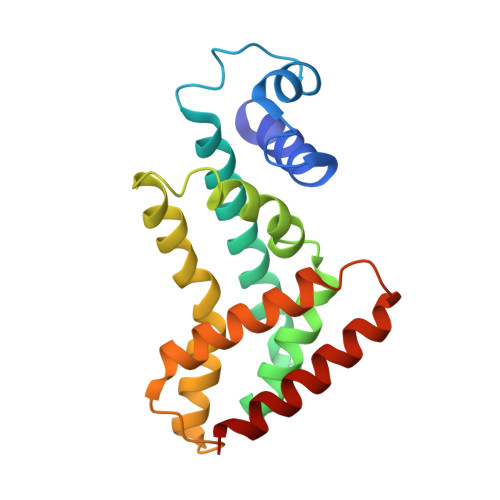Crystal structures of QacR-diamidine complexes reveal additional multidrug-binding modes and a novel mechanism of drug charge neutralization.
Murray, D.S., Schumacher, M.A., Brennan, R.G.(2004) J Biol Chem 279: 14365-14371
- PubMed: 14726520
- DOI: https://doi.org/10.1074/jbc.M313870200
- Primary Citation of Related Structures:
1RKW, 1RPW - PubMed Abstract:
The Staphylococcus aureus multidrug-binding protein QacR represses transcription of the plasmid-encoded membrane protein QacA, a multidrug efflux transporter. QacR is induced by multiple structurally dissimilar monovalent and bivalent cationic lipophilic compounds, many of which are effluxed from the cell by QacA via the proton motive force. The multidrug-binding pocket of QacR has been shown to be quite extensive and features several glutamates and multiple aromatic residues. To date, the structure of only one QacR-bivalent cationic drug complex (that of QacR bound to dequalinium) has been determined, and how other longer or shorter bivalent cationic compounds bind is unknown. Here we report the crystal structures of QacR bound to two cytotoxic bivalent diamidines, pentamidine and hexamidine. These compounds are structurally similar, differing by only one methylene carbon in the alkyl chain linker. However, this small difference results in very dissimilar binding modes. Similar to dequalinium, hexamidine spans the multidrug-binding pocket, and its positively charged benzamidine groups are neutralized by residues Glu-57 and Glu-120. Pentamidine binds QacR in a novel fashion whereby one of its benzamidine groups interacts with residue Glu-63, and the other is neutralized by carbonyl and side chain oxygen atoms. Thus, these structures demonstrate that a formal negative charge is not a prerequisite for binding positively charged drugs and underscore the versatility of the QacR and, likely, all multidrug-binding pockets.
Organizational Affiliation:
Department of Biochemistry and Molecular Biology, Oregon Health and Science University, Portland, Oregon 97239-3098, USA.
















